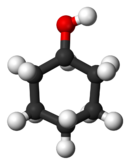Cyclohexanol
| |||
| Names | |||
|---|---|---|---|
| IUPAC name
Cyclohexanol
| |||
| Other names
Cyclohexyl Alcohol,
hexahydrophenol, hydrophenol, hydroxycyclohexane, Naxol | |||
| Identifiers | |||
3D model (JSmol)
|
|||
| ChEMBL | |||
| ChemSpider | |||
| ECHA InfoCard | 100.003.301 | ||
| KEGG | |||
PubChem CID
|
|||
| RTECS number |
| ||
CompTox Dashboard (EPA)
|
|||
| |||
| |||
| Properties | |||
| C6H12O | |||
| Molar mass | 100.158 g/mol | ||
| Appearance | Colorless, viscous liquid. Hygroscopic | ||
| Density | 0.962 g/mL, liquid | ||
| Melting point | 25.93 °C (78.67 °F; 299.08 K) | ||
| Boiling point | 160.84 °C (321.51 °F; 433.99 K) | ||
| 3.60 g/100 mL (20 °C) | |||
| Acidity (pKa) | 16 | ||
| Viscosity | 41.07 mPa·s (30 °C) | ||
| Hazards | |||
| Occupational safety and health (OHS/OSH): | |||
Main hazards
|
Flammable, skin irritant Reacts violently with oxidizing agents | ||
| Flash point | 67 °C | ||
| Lethal dose or concentration (LD, LC): | |||
LD50 (median dose)
|
2.06 g/kg (oral, rat) | ||
Except where otherwise noted, data are given for materials in their standard state (at 25 °C [77 °F], 100 kPa).
| |||
Cyclohexanol is the organic compound with the formula (CH2)5CHOH. The molecule is related to cyclohexane ring by replacement of one hydrogen atom by a hydroxyl group.[2] This compound exists as a deliquescent colorless solid, which, when very pure, melts near room temperature. Billions of kilograms are produced annually, mainly as a precursor to nylon.[3]
Production
Cyclohexanol is produced by the oxidation of cyclohexane in air, typically using cobalt catalysts:[3]
- C6H12 + 1/2 O2 → C6H11OH
This process co-forms cyclohexanone, and this mixture ("KA oil" for ketone-alcohol oil) is the main feedstock for the production of adipic acid. The oxidation involves radicals and the intermediacy of the hydroperoxide C6H11O2H. Alternatively, cyclohexanol can be produced by the hydrogenation of phenol:
- C6H5OH + 3 H2 → C6H11OH
This process can also be adjusted to favor the formation of cyclohexanone.
Basic reactions
Cyclohexanol undergoes the main reactions expected for a secondary alcohol. Oxidation gives cyclohexanone, which is converted on a large scale in industry to the oxime, a precursor to caprolactam. As a laboratory exercise, this oxidation can be effected with chromic acid. Esterification affords the commercially useful derivatives dicyclohexyladipate and dicyclohexylphthalate, which are used as plasticizers. Heating in the presence of acid catalysts converts cyclohexanol to cyclohexene.[3]
Structure
Cyclohexanol has at least two solid phases. One of them is a plastic crystal.
Applications
As indicated above, cyclohexanol is an important feedstock in the polymer industry, firstly as a precursor to Nylons, but also to various plasticizers. Small amounts are used as a solvent.
Safety
Cyclohexanol is somewhat toxic: the TLV for the vapor for 8 h is 50 ppm.[3] Few studies have been done on its carcinogenicity, but one study on rats found it to have co-carcinogenic effects.[4]
References
- ^ Merck Index, 11th Edition, 2731.
- ^ Lide, D. R., ed. (2005). CRC Handbook of Chemistry and Physics (86th ed.). Boca Raton (FL): CRC Press. ISBN 0-8493-0486-5.
- ^ a b c d Michael Tuttle Musser "Cyclohexanol and Cyclohexanone" in Ullmann's Encyclopedia of Industrial Chemistry, Wiley-VCH, Weinheim, 2005.
- ^ [1] Lucrecia Márquez-Rosado, Cristina Trejo-Solís 2, María del Pilar Cabrales-Romero, Evelia Arce-Popoca, Adolfo Sierra-Santoyo, Leticia Alemán-Lazarini, Samia Fatel-Fazenda, Claudia E. Carrasco-Legleu, Saúl Villa-Treviño, "Co-carcinogenic effect of cyclohexanol on the development of preneoplastic lesions in a rat hepatocarcinogenesis model", Molecular Carcinogenesis, Vol. 46, No. 7, Pages 524 - 533, March 2007.


